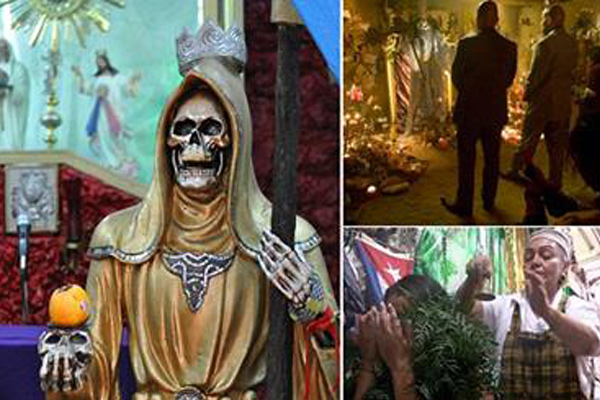
The Lady of Death, or Santa Muerte, became popular after being in AMC’s hit show Breaking Bad, but where did this faith come from and who does it worship?
After steadily increasing its global religious presence over the past 15 years, the religion known as Our Lady of the Holy Death jumped dramatically in numbers following its exposure during a scene in a 2010 episode of AMC’s Breaking Bad. In the season 3 opener, protagonist Walter White, aka Heisenberg, has attracted the wrong kind of attention from the Juarez Cartel. Twin hitmen known as the Cousins have been sent to New Mexico to remove Heisenberg from competition. Before crossing the border, the Cousins stop at a shrine in a tiny Mexican pueblo to pay their respects and ask the Lady of Death, Santa Muerte, for success in their mission.
Our Lady of the Holy Death functions as an organized religion, including priests, weekly services, communion and rosaries. The Patron Saint even looks a lot like iconic depictions of the Virgin Mary. However, while the Vatican acknowledges that this Catholic-Aztek witchcraft hybrid appeals to those disillusioned by traditional understandings of God, it does not recognize Santa Muerte as a sister religion in any way, calling it “sinister and infernal.”
History and Practices of Santa Muerte
The first day of each month marks a holy day for followers of the world’s fastest growing religious movement. Santa Muerte, Our Lady of the Holy Death, is the patron saint of this new religion, which originated in Mexico and already claims 10 to 12 million devotees after just 13 years in the public eye. This obsession with the White Lady is perhaps understandable in Mexico, where the murder rate has topped 80,000 since 2006.
Followers of Santa Muerte were formerly secretive, keeping shrines to the holy lady hidden in closets. Then in 2001 a devotee named Enriqueta Romero set up the first public shrine in the Mexico City neighborhood of Tepito; the practice spread through Mexico like wildfire, jumped the borders to spread throughout Latin America and certain Latino-dense American cities, and today can be found as far afield as Japan and Australia.
In a typical private ceremony, worshipers can receive exorcism and warding of evil spirits, using cigar smoke, fragrant leaves, and incantations.Promises of certain gifts are made in exchange for protection, soul purification, and a painless death.
Universal Appeal
Perhaps the universality of Santa Muerte explains why it is so popular and experiencing such growth. The religion accepts all, regardless of other religion, sexual orientation, race, age, marital status, even opinions on the afterlife. After all, while we may not know exactly what comes next, we all die eventually. Death comes to fringe members of society such as gays, drug dealers, and the mentally unstable just as much as it does to politicians, mothers, and engineers. With this perspective, it makes sense to pay homage to the gatekeeper waiting for us all.
As part of its inclusivity, Our Lady of the Holy Death does not demand to be the only religion in a person’s life. This allows Catholics, of which Mexico contains a high percentage, and those of a wide variety of other backgrounds to use this as a supplement to other forms of faith. The appeal of this casual faith becomes apparent after the realization that some activities might not evoke approval from more traditional deities or saints. Consider the spiritual needs of a pickpocket, a drug agent, or even the seeker of a lost sex toy that could cause awkwardness if found in the wrong place.
The unusual aspect of praying to Santa Muerte is that she doesn’t make any distinction whether you are asking for a good thing or a bad thing. So responsibility falls to the petitioner to essentially “be careful what you wish for.” This feature allows followers such as, say, the Cousins visiting a Santa Muerte shrine, to ask for help with such questionable undertakings as safely manufacturing and distributing blue meth, or killing off the competition. The White Lady doesn’t judge motives, she only requires some payment in return in the form of prayers, tokens, or promises–whatever the petitioner holds dear. She even accepts payment in the form of tequila.
